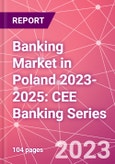Deposit Dynamics: Notable 11%+ Growth to PLN 1.92 Trillion Reflects Polish Clients' Trust in Banks
This report is the latest full update of the comprehensive annual publication about the banking sector in Poland. It describes the present market structure and recent trends in the market and also provides short-term estimates of key banking volumes for the years 2023 through 2025.
Compared to the previous edition, it has been revised and updated. When preparing this report, the analyst responded to feedback received from its clients and incorporated several improvements that make this new issue even more reader-friendly and informative.
Market Highlights
The surge in market interest rates, rising from zero to approximately 6.5% in 2022, had a profound impact on the banking sector in Poland. The escalating cost of money significantly influenced the new investment demand of corporations, while simultaneously limiting the capacity of individuals to secure new loans. Conversely, the notably higher interest rates, though still below inflation, spurred interest in depositing funds in banks. Consequently, overall client deposits at banks reached PLN 1.92 trillion in Q2 2023, reflecting an 11%+ change over 1½ years since the end of 2021. Concurrently, client loans experienced a contraction of over 2%, decreasing from PLN 1.29 trillion at the close of 2021 to PLN 1.26 trillion in Q2 2023.
However, the impact of higher interest rates has proven overall beneficial for banks thus far. In 2022, banks operating in Poland recorded PLN 93 billion in net revenue (EUR 20 billion) and realized PLN 10.8 billion in net profits (EUR 2.4 billion). The effect of higher interest rates has positively influenced the net interest margin of banks and is anticipated to continue, at least until the growing cost of risk offsets it. The benchmarks for Return on Assets (ROA) and Return on Equity (ROE) for the total market improved in 2022 to 0.41% and 5.4%, respectively and they are expected to improve further in 2023.
Table of Contents
Executive Summary
The competitive landscape within the Polish banking sector has not changed much over the past few years. The group of major commercial banks remained unchanged, concurrently increasing its market share slightly, indicating a trend toward growing concentration. Noteworthy in this context is the government-owned SPV Bank - BGK, which has ascended the top list of banks due to its exclusive rights in distributing support and lending funds from both the government and the EU. While there has been little M&A activity in the banking sector recently, an exception from this trend is Velo Bank. This institution is currently available for acquisition following a compelled restructuring and takeover by the government of the erstwhile Getin Noble Bank. The sales tender is presently open, with expectations for closure early in 2024.
The surge in market interest rates, rising from zero to approximately 6.5% in 2022, had a profound impact on the banking sector. The escalating cost of money significantly influenced the new investment demand of corporations, while simultaneously limiting the capacity of individuals to secure new loans. Conversely, the notably higher interest rates, though still below inflation, spurred interest in depositing funds in banks. Consequently, overall client deposits at banks reached PLN 1.92 trillion in Q2 2023, reflecting an 11%+ change over 1.5 years since the end of 2021. Concurrently, client loans experienced a contraction of over 2%, decreasing from PLN 1.29 trillion at the close of 2021 to PLN 1.26 trillion in Q2 2023.
Despite many challenges, the future outlook for key banking volumes remains favorable. Total banking assets are projected to grow steadily, potentially reaching PLN 3.5 trillion by the end of 2025.
Companies Mentioned
- Alior Bank
- Bank Pekao
- BNP Paribas
- Citibank Handlowy
- Getin Noble Bank (Previously owned Velo Bank before a compelled restructuring)
- ING Bank
- mBank
- Millennium
- Pekao
- PKO Bank Polski
- Santander
- SPV Bank - BGK (Government-owned)
- Velo Bank (Currently available for acquisition, previously owned by the government of Getin Noble Bank)








